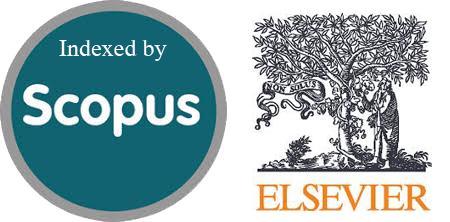تقييم هلام باليبيريدون الحراري الموضعي خارج الجسم وداخله كنظام توصيل من الأنف إلى الدماغ في الفئران
DOI:
https://doi.org/10.54133/ajms.v9i2.2460الكلمات المفتاحية:
Bioavailability.، Ex vivo، Nasal-to-brain delivery، Paliperidone، Thermal gelالملخص
الخلفية: يُعدّ دواء باليبيريدون (PAL)، وهو دواء مضاد للذهان، محدود التوافر في الدماغ عند إعطائه بالطرق التقليدية نظرًا لضعف اختراقه للحاجز الدموي الدماغي وآثاره الجانبية الجهازية. يُقدّم الإعطاء الأنفي استراتيجيةً غير جراحية واعدة للاستهداف المباشر للدماغ. الهدف: هدفت هذه الدراسة إلى دراسة الحرائك الدوائية وكفاءة استهداف الدماغ لمعلق نانوي مُحمّل باليبيريدون (NB-IG7)، المُصمّم على شكل جل موضعي مُستجيب للحرارة لتوصيل الدواء من الأنف إلى الدماغ، مقارنةً بالإعطاء الوريدي. الطريقة: تلقّت ذكور الفئران دواء باليبيريدون إما عن طريق الأنف جل NB-IG7 الموضعي أو عن طريق الوريد. قُيّمت تركيزات الدواء في البلازما والدماغ على مدار 48 ساعة، وحُدّدت معايير الحرائك الدوائية. قُيّمت كفاءة استهداف الدماغ باستخدام كفاءة استهداف الدواء (DTE)، ومؤشر استهداف الدواء (DTI)، ونسبة نقل الدواء (%DTP). النتائج: حقق إعطاء NB-IG7 عن طريق الأنف تركيزات أعلى بكثير من PAL في الدماغ مقارنةً بالإعطاء الوريدي. بلغ أقصى تركيز للدم في الدماغ وAUC0-48 ساعة 1.89 ميكروغرام/مل و63.6 ساعة·ميكروغرام/مل على التوالي، مما يمثل زيادة قدرها 2.66 و2.68 ضعفًا مقارنةً بالإعطاء الوريدي (أقصى تركيز 0.71 ميكروغرام/مل، AUC0-48 ساعة 23.7 ساعة·ميكروغرام/مل؛ قيمة P<0.05). كان التعرض للبلازما أقل بعد إعطاء الدواء عن طريق الأنف (أقصى تركيز 0.19 ميكروغرام/مل، AUC0-48 ساعة 4.66 ساعة·ميكروغرام/مل) مقارنةً بالجرعة الوريدية (أقصى تركيز 0.87 ميكروغرام/مل، AUC0-48 ساعة 13.98 ساعة·ميكروغرام/مل). أظهر تقييم استهداف الدماغ تحسنًا ملحوظًا في القيم (DTE 807%، DTI 8، وDTP 91%)، مما يؤكد كفاءة نقل الدواء من الأنف إلى الدماغ عبر مسارات الشم و/أو العصب الثلاثي التوائم. الاستنتاجات: أظهر المعلق النانوي المحمّل بـ PAL في هلام موضعي مستجيب للحرارة (NB-IG7) استهدافًا أفضل للدماغ وانخفاضًا في التعرض الجهازي مقارنةً بالتوصيل الوريدي. تُوفر هذه الاستراتيجية بديلًا واعدًا لتوصيل PAL بفعالية من الأنف إلى الدماغ، مما قد يُحسّن النتائج العلاجية في علاج الفصام.
التنزيلات
المراجع
Jaafer H, Al-Kinani KK. Formulation and evaluation of idebenone microemulsion as a potential approach for the transmucosal drug delivery systems. Iraqi J Pharm Sci. 2024;33(1):79-88. doi: 10.31351/vol33iss1pp79-88. DOI: https://doi.org/10.31351/vol33iss1pp79-88
Cassano R, Servidio C, Trombino S. Biomaterials for drugs nose–brain transport: a new therapeutic approach for neurological diseases. Materials. 2021;14(7):1802. doi: 10.3390/ma14071802. DOI: https://doi.org/10.3390/ma14071802
Jeong SH, Jang JH, Lee YB. Drug delivery to the brain via the nasal route of administration: exploration of key targets and major consideration factors. J Pharm Investig. 2023;53(1):119-152. doi: 10.1007/s40005-022-00589-5. DOI: https://doi.org/10.1007/s40005-022-00589-5
Shelar S, Mujawar NK, Chakorkar SS. In-vivo and ex-vivo methods: Advancing the frontiers of ocular pharmacological researches. Int J Pharm Sci Res. 2024;15(1):78-86. doi: 10.13040/IJPSR.0975-8232. DOI: https://doi.org/10.13040/IJPSR.0975-8232
Minwalla HD, Wrzesinski P. Paliperidone to treat psychotic disorders. Neurol Int. 2020;12(3). doi: 10.3390/neurolint13030035. DOI: https://doi.org/10.3390/neurolint13030035
Bhandari PR, (Ed.), Textbook of Pharmacology, (1st Edition), Thieme publisher, October 10, 2022.
Das P, Panda J, Panigrahi KC. Optimal mixture design enabled development of lyophilized nanoemulsifying drug delivery system of paliperidone. Drug Deliv Lett. 2024;14(2). doi: 10.2174/0122103031273803231221070539. DOI: https://doi.org/10.2174/0122103031273803231221070539
Kumbhar SA, Kokare CR, Shrivastava B, Gorain B, Choudhury H. Preparation, characterization, and optimization of asenapine maleate mucoadhesive nanoemulsion using Box-Behnken design: In vitro and in vivo studies for brain targeting. Int J Pharm. 2020;586:119499. doi: 10.1016/j.ijpharm.2020.119499. DOI: https://doi.org/10.1016/j.ijpharm.2020.119499
Rashid AM, Abdal-Hammid SN. Formulation and characterization of itraconazole as nanosuspension dosage form for enhancement of solubility. Iraqi J Pharm Sci. 2019;28(2):124–133. doi: 10.31351/vol28iss2pp124-133. DOI: https://doi.org/10.31351/vol28iss2pp124-133
Hussien RM, Ghareeb MM. Formulation and characterization of isradipine nano particle for dissolution enhancement. Iraqi J Pharm Sci. 2021;30(1):218-225. doi: 10.31351/vol30iss1pp218-225 DOI: https://doi.org/10.31351/vol30iss1pp218-225
Obayes KK, Thomas LM. Development and characterization of hyaluronic acid-incorporated thermosensitive nasal in situ gel of meclizine hydrochloride. Al-Rafidain J Med Sci. 2024;6(1):97-104. doi: 10.54133/ajms.v6i1.499. DOI: https://doi.org/10.54133/ajms.v6i1.499
Alkufi HK, Kassab HJ. Formulation and evaluation of sustained release sumatriptan mucoadhesive intranasal in-situ gel. Iraqi J Pharm Sci. 2019;28(2):95–104. doi: 10.31351/vol28iss2pp95-104. DOI: https://doi.org/10.31351/vol28iss2pp95-104
Salih OS, Al-Akkam EJ. Preparation, in-vitro, and ex-vivo evaluation of ondansetron loaded invasomes for transdermal delivery. Iraqi J Pharm Sci. 2023;32(3):71-84. doi: 10.31351/vol32iss3pp71-84. DOI: https://doi.org/10.31351/vol32iss3pp71-84
Abou Hussein DMN. Enhanced transdermal permeation of BCS class IV aprepitant using binary ethosome: Optimization, characterization and ex-vivo permeation. J Drug Deliv Sci Technol. 2021;61:102185. doi: 10.1016/j.jd.2020.102185. DOI: https://doi.org/10.1016/j.jddst.2020.102185
Reagan-Shaw S, Nihal M, Ahmad N. Dose translation from animal to human studies revisited. FASEB J. 2008;22(3):659-661. doi: 10.1096/fj.07-9574LSF. DOI: https://doi.org/10.1096/fj.07-9574LSF
Jabir SA, Rajab NA. Preparation, in-vitro, ex-vivo, and pharmacokinetic study of lasmiditan as intranasal nanoemulsion-based in situ gel. Pharm Nanotechnol. 2025;13(1):239-253. doi: 10.31351/vol33iss3pp128-141. DOI: https://doi.org/10.2174/0122117385285009231222072303
Wang F, Yang Z, Liu M, Tao Y, Li Z, Wu Z, et al. Facile nose-to-brain delivery of rotigotine-loaded polymer micelles thermosensitive hydrogels: In vitro characterization and in vivo behavior study. Int J Pharm. 2020;577:119046. doi: 10.1016/j.ijpharm.2020.119046. DOI: https://doi.org/10.1016/j.ijpharm.2020.119046
Nguyen TT, Maeng HJ. Pharmacokinetics and pharmacodynamics of intranasal solid lipid nanoparticles and nanostructured lipid carriers form nose-to brain delivery, Pharmaceutics. 2022;14(1). doi: 10.3390/pharmaceutics14030572. DOI: https://doi.org/10.3390/pharmaceutics14030572
Rudragangaiah S, Bhatta RG, Kotappa SB. Stability-indicating RP-HPLC method for the quantification of paliperidone in bulk and solid dosage form to establish validation and stability indicating parameters. Indian J Pharm Edu Res. 2019;3(5):166. doi: 10.5530/ijper.53.4s.166. DOI: https://doi.org/10.5530/ijper.53.4s.166
Pardeshi CV, Belgamwar VS, Surana SJ. Nanotechnology-mediated nose-to-brain drug delivery for neurodegenerative disorders. In: Rai M, Yadav A, (Eds), Nanobiotechnology in Neurodegenerative Diseases, Springer, Cham. doi: 10.1007/978-3-030-30930-5_6. DOI: https://doi.org/10.1007/978-3-030-30930-5_6
Tamer MA, Kassab HJ. The development of a brain targeted mucoadhesive amisulpride loaded nanostructured lipid carrier. Farmacia. 2023;71(5). doi: 10.31925/farmacia.2023.5.18. DOI: https://doi.org/10.31925/farmacia.2023.5.18
Gandhi S, Shastri DH, Shah J, Nair AB, Jacob S. Nasal delivery to the brain: harnessing nanoparticles for effective drug transport. Pharmaceutics. 2024;16(4):481. doi: 10.3390/pharmaceutics16040481. DOI: https://doi.org/10.3390/pharmaceutics16040481
Gu F, Ma W, Meng G, Wu C, Wang Y. Preparation and in vivo evaluation of a gel-based nasal delivery system for risperidone. Acta Pharm. 2016;66(4):555-562. doi: 10.1515/acph-2016-0047. DOI: https://doi.org/10.1515/acph-2016-0047
Alexander A, Agrawal M, Bhupal Chougule M, Saraf S, Saraf S. Nose-to-brain drug delivery: an alternative approach for effective brain drug targeting. In: Shegokar R, (Editor), Nano pharmaceuticals. Elsevier; 2020. p. 178. doi: 10.1016/B978-0-12-817778-5.00009-9. DOI: https://doi.org/10.1016/B978-0-12-817778-5.00009-9
Ezzat SM, Salem MA, El Mahdy NM, Ragab MF. Rivastigmine. In: Belwal T, Nabavi SM, Nabavi SF, Dehpour AR, Shirooie S, (Editors), Naturally occurring chemicals against Alzheimer's disease. Academic Press; 2021. p. 93-108. doi: 10.1080/10611860600721051. DOI: https://doi.org/10.1016/B978-0-12-819212-2.00007-4
Hamzah ML, Kassab HJ. Frovatriptan succinate intranasal delivery for brain targeting–in vivo study. Iraqi J Vet Med. 2023;47(2):101–109. doi: 10.30539/me2mm152. DOI: https://doi.org/10.30539/me2mm152
Alkufi HK, Kassab HJ. Nano spanlastic in situ gel for nose to brain delivery of nimodipine: In vitro optimization, and in vivo pharmacokinetic study. Al-Rafidain J Med Sci. 2025;8(1):97-105. doi: 10.54133/ajms.v8i1.1687. DOI: https://doi.org/10.54133/ajms.v8i1.1687

التنزيلات
منشور
كيفية الاقتباس
إصدار
القسم
الرخصة
الحقوق الفكرية (c) 2025 Al-Rafidain Journal of Medical Sciences

هذا العمل مرخص بموجب Creative Commons Attribution-NonCommercial-ShareAlike 4.0 International License.
Published by Al-Rafidain University College. This is an open access journal issued under the CC BY-NC-SA 4.0 license (https://creativecommons.org/licenses/by-nc-sa/4.0/).










